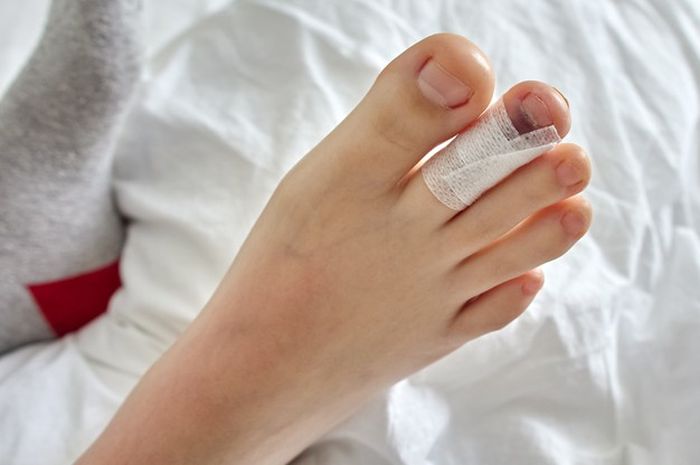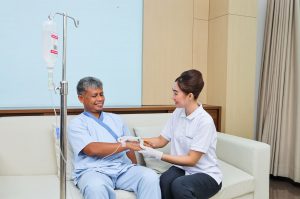Diabetic wounds and gangrene wounds are two types of wounds that are often related. Improper management of diabetic wounds can cause the onset of gangrene. Gangrene is a dangerous and potentially fatal condition that occurs when blood flow to an area of body tissue is cut off. People with diabetes are more at risk of experiencing gangrene which can lead to amputation of the affected parts of the body.
Causes Of Diabetic Wounds
Diabetes is a disease characterized by higher than normal blood sugar levels. Diabetes patients are prone to experiencing injuries that can unwittingly develop and result in serious consequences. Due to high blood sugar levels, the patients often experience narrowed and/or hardened blood vessel problems. This problem causes the blood supply throughout the body to be disrupted.
So, even the most minor wound may pose a risk of harmful complications. This is because the wounded part cannot receive an adequate supply of oxygen-rich blood and nutrients which are important for accelerating wound healing. People with diabetes are also prone to nerve damage or diabetic neuropathy of the legs. Because of this condition, the patients are unaware of the wounds until they eventually spread and become infected. High blood sugar levels can make it difficult for the body to fight infections so that the patients are at risk of gangrene.
Therefore, it is important for people with diabetes to prevent wounds. Diabetic wounds often occur in the lower extremity, especially in the legs. The most common causes include calluses, dry skin, and the use of ill-fitting shoes. When a wound has occurred, it has to be treated properly to prevent complications such as gangrene.
Necessary Equipment for Diabetic Wound Care
Diabetic wounds should be treated by a doctor or trained medical personnel. However, the management of diabetic wounds that are mild or in the early stages can be done alone at home if the patients or their family members have understood how to properly treat diabetic wounds. Simple equipment needed to treat diabetic wounds include:
- Sterile gloves
- Bandage scissors
- Medical alcohol
- 0.9% NaCL liquid
- Tweezers
- Sterile gauze
- Cotton
- Bandages
- Roll plaster
- Diabetes wound medicine according to doctor’s prescription
- Sheets
Steps to Treat Diabetic Wounds
Diabetic wounds require proper care to prevent complications. The steps to treat diabetic wounds are described below:
- Wash hands with soap and running water
- Wear gloves
- Put the wounded part on the sheets
- Wet the wound dressing with medical alcohol
- Gently remove the outermost layer with tweezers
- Clean the skin area around wounds and any marks of plaster
- Open the inner layer
- Gently press the edges of the wound to remove pus
- Clean the wound with NaCL liquid
- Cover with gauze
- Put bandages and plaster back on
What Are the Complications of Diabetes and Gangrene Wounds
People with diabetes need to be aware of the wounds that occur to them. Even small scratches on the legs can develop into wider and more serious wounds that can lead to complications. The most dangerous complications are gangrene and amputation. Other common complications of diabetic wounds include:
- Skin infections: the skin around the wound area can be infected by germs, causing it to swell and produce an unpleasant smell. The infection also causes fever in the patient. When the infection spreads to the bone, the risk of amputation will increase.
- Abscess formation: when a diabetic wound is infected, there is a possibility of abscess formation, which is a collection of pus under the skin that causes pain.
- Sepsis: when the infection penetrates deep into the skin, there is a risk of sepsis because the blood vessels are also infected. Sepsis is a condition when the body’s immune system overreacts to an infection, causing damage to tissues and organs.
- Foot deformities: diabetic wound infections can weaken bones and muscles, leading to deformities of the legs.
How to Prevent Complications of Diabetic Wounds and Gangrene Wounds
In the event of diabetic wounds, the patients should be immediately alerted and given appropriate treatment to prevent complications. There are several ways to reduce the risk of diabetic wounds and their complications, including gangrene and amputation. Among them:
- Keep the feet clean, use mild soap and lukewarm water
- Dry your feet with a soft cloth after cleaning
- Control your blood sugar, especially by eating healthy foods
- Regularly check the condition of your feet in order to know in time any possible injuries
- Wear fit and comfortable shoes
- Before using shoes, make sure there are no sharp objects or other objects that could cause injury
- Avoid going outdoors barefoot
- Lead an active lifestyle
- Maintain a healthy weight
- Quit smoking for smokers
- Control cholesterol levels and blood pressure
- If you notice any wounds to the legs, including calluses, you should go to the doctor for consultation
- Wear dry and clean socks, avoid tight socks because they can inhibit blood circulation
- See your doctor regularly
Tips for Treating Diabetic Wounds at Home
The management of diabetic wounds requires special knowledge and expertise. If you are unsure, it is best to do treatment at a health care facility with the help of doctor or medical personnel. At home, you can also treat diabetic wounds with simple steps such as the following:
- Do not apply pressure to the wound. Disabled diabetic patients may need a wheelchair or crutches to move around so as not to put pressure on the foot wound.
- Be sure to check your blood sugar regularly. Uncontrolled high blood sugar slows the healing process.
- Apply a diet with balanced nutrition every day to meet the nutritional needs needed to accelerate wound healing.
- Clean the wound regularly and keep the dressing dry.
The role of the family in the treatment of diabetic wounds at home is very much needed, especially for elderly patients or other patients with limitations due to their condition. Family participation in diabetic wound management is effective in improving blood sugar control and wound healing.



